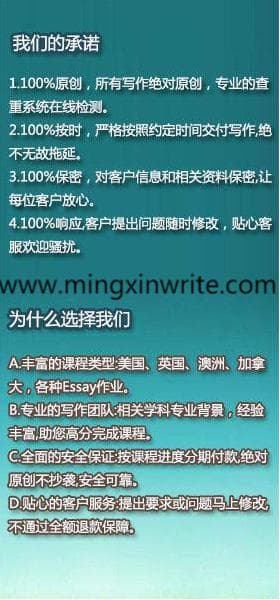发布时间:2020-12-19 热度:
留学生会计论文代写、金融学Essay代写,经济金融学report/essay/assignment/paper代写,金融作业代写_金融学assignment_留学生金融作业格式范文,深处行业多年,高质量,纯原创,绝对私密。各类科目教员均出自专业PhD团队。 价格透明,可分期支付,不合格全退款,无烦恼。无论作业考试,放心地让我们帮你处理,高分无忧。代写留学生金融学毕业论文-Finance Thesis-金融学Assignment.

金融学论文范文选节:
Financial analysis of coles ltd
1. INTRODUCTION
1.1 Purpose
In this report my purpose is to do a financial analysis of Coles Ltd which provides a basis, on which the valuation of company can be done.
1.2 Scope
This report conducts a financial analysis for Coles by performing a trend analysis of financial ratios using the data given for past 5 years. It also includes a cash flow analysis which along with financial ratios helps compare coles with its industry counterparts, Woolworths and Metcash; and finally this analysis would help in price valuation to calculate a fair price for coles share.
1.3 Methodology
This report is based on primary data available from Coles website as well as secondary data such as research paper, electronic database and other publications.
1.4 Limitation
Although all efforts have been made to use as much available information as possible but there were some constricting factors such as lack of available data of past financial information which restricted this research. Reliability of data and time constraints were also hurdle in performing this analysis.
The biggest shortcoming was that current data was based on AIFR and data for years before 2005 was based on AGAAP, which made comparative trend analysis very difficult.
2. FINANCIAL ANALYSIS
In this we will be evaluating the firm's financial ratios and cash flow measures of the operating, financing, and investing performance of a company in relation to key competitors & historical performance. Given the firm's strategy and goals, together these tools allow the analyst to investigate and examine a firm's performance and its financial condition.
Ratio analysis is the tool which involves assessing the firm's income statement and balance sheet data. On the other side, the cash flow analysis relies on firm's cash flow statement.
2.1 Ratio analysis
The ratio analysis deals with evaluation of the performance of Coles in perspective of its mentioned strategies and goals. In order to achieve this objective a combination of cross sectional analysis and time series analysis is performed. Workings of Ratios for 2006 are mentioned in APPENDIX 4.
2.1.1 Profitability analysis
If we look at the return on equity (ROE) of Coles, for a period of 5 years, it is being observed that ROE has increased in 2006 as compared to 2002. Although ROE has fallen in 2006 (15. 30%) as compared to 2005 (18.30 %) but it can be seen that on an average Coles ROE has been stable or increased over last 5 years. Return on asset (ROA) has also been stable around 10% during the last 3 years and increasing from 7.17% in 2002 to 9.54% in 2006.The main reason for stable ROE and ROA are better performance delivered by the management and as well as the mature characteristic of the industry, that produces stable return as well as stable growth seeing population demographics in the country.
Gross profit has been quite stable and good for the last 5 years but the concerned part is the net profit margin. Net profit margin has been very low, it had been increasing from 2002 to 2005 but it again fell in 2002 to 1.57% from 2.08%. Coles need to reduce its operating and interest expenses so as to increase its net profit margin.
On comparing the performance of Coles with its industry counterparts we can conclude that Coles Ltd is way behind its major competitor, Woolworths, in terms of ROE and ROA which might be attributable to lower net profit margin and lower financial leverage. Coles has higher financial leverage as compared to Woolworths and metcash, which means it, has greater financial risk. But despite of high leverage it has low ROE which confirms the fact that Coles has low net profit margin & asset turnover ratio.
2.1.2 Activity Analysis
A firm's operating activities require investments in both short-term (inventory and accounts receivable) and long term assets. Activity ratios describe the relationship between the firm's level of operations and assets needed to sustain operating activities. Asset turnover is important in determining firms ROA; it also formulates reasons of how it will affect firm's ROE. Evaluating the effectiveness of asset management is the purpose of asset turnover analysis.
2.1.2.1 Short term activity ratios
Working capital is our main concern while evaluating a company. It can clearly be observed that since Coles has high turnover ratios it uses cash basis in its sales. It can be clearly being seen that it took only 4.48 days on an average for Coles to convert its inventory investment back in to cash. From the figures last 5 years we can clearly interpret that Coles has drastically improved its cash conversion cycle from 23 days in 2002 to 4.48 days in 2006.
Now, if we compare Coles with its competitors we can see that Woolworths has lower cash conversion cycle and metcash has higher cash conversion cycle. Woolworths has lower cash conversion cycle because it keeps inventory in stock for shorter duration and stock is converted in to good sold in less span of time. On the other hand Metcash keeps inventory in stock for lower no. of days but it provides more no. of days to its receivables for payment due to which it has higher cash conversion cycle. Seeing the industry it can be concluded that Coles has good cash conversion cycle but it can improve on it by reducing the Average number of days for which inventory is in stock.
2.1.2.2 Long term activity ratios
In the analysis of long term activity ratios, long-term asset turnover and property, plant and equipment turnover have been utilized.
On the whole both ratios moved in the same pattern during these periods. Relatively, this pattern shows that asset utilization has improved uniformly for the period ranging from 2002 (310.12%) to 2006(372.70%). This helps to conclude that company is continuously improving its utilization of assets to increase its production.
While comparing to its competitors it can be seen that Cole's total asset turnover ratio is approximately 30% higher than its competitors. It helps to analyze that Coles is more efficiently utilizing its resources to increase its production as compared to its competitors. Metcash's high PPE turnover ratio can be contributed to the fact that PPE forms a very small part of Metcash's total assets. If compare Coles with its major competitor Woolworth on PPE Turnover Ratio we can conclude that Coles has been utilizing its fixed asset better than Woolworths.
2.1.3 Liquidity Analysis
Liquidity is referred to a firm's ability to have sufficient funds when needed and convert its non-cash assets in to cash easily. Liquidity Ratios are employed to determine the firm's ability to pay its short-term liabilities. Liquidity analysis enables us to determine Cole's ability to cover its liquidity risk. Liquidity risk may arise due to shortfall or over liquidity within the firm and this in turn lead to firm's disability of fulfilling its liquidity needs.
In order to determine firm liquidity level, Current ratio, quick ratio and cash ratio are short- term liquidity ratios which have been employed.
On doing the trend analysis for last 5 years it can be observed that Coles current ratio has been consistently falling, which increases the possibility that Coles will not be able to meet up its short term liabilities. Current ratio has fallen from 1.37 in 2002 to 0.98 in 2006 which is of major concern, as a current ratio of less than 1 means that company has negative working capital and is probably facing a liquidity crisis. The more stringent measure of liquidity is quick ratio and cash ratio which have also been falling uniformly in last 5 years. It seems Coles is falling in to liquidity crunch and might need short term funds to meet its current liabilities. There has been lot of volatility in the cash ratio of the firm as they have been rising and again falling, so we can conclude that Coles is not able to maintain stable liquidity.
As compared to its competitors Coles has better current ratio than Woolworths but has current ratio less than Metcash. Comparing Coles with its major competitor in retail sector, Woolworth, we can clearly see Coles has better current & cash ratio but is behind on quick ratio. On comparing with metcash we see that Coles is behind on all the short term liquidity ratios by a very high margin. Metcash has twice the cash ratio as compared to Coles, which makes Coles ability to meet its short term liabilities questionable.








